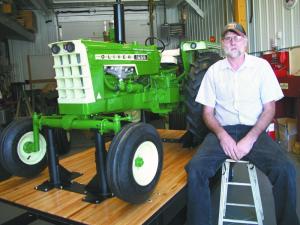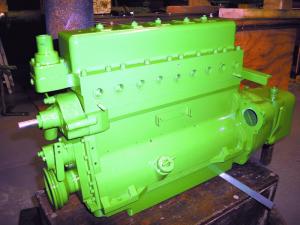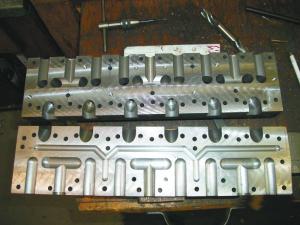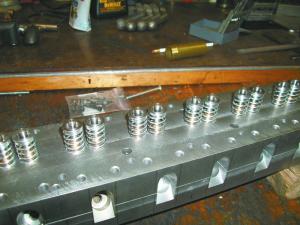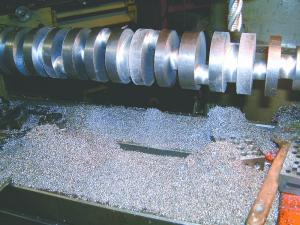Half-Scale Oliver 1655 Masterpiece “Built From Scratch”
As a growing and inquisitive youngster, Rich Dosdall spent countless hours in his dad’s Oliver equipment dealership, learning all he could about how tractors were built. That love of Olivers reached its pinacle in April, 2018, when he attached an 18-volt cordless drill to the starter on his hand-built, half-scale Oliver 1655 tractor and heard it sputter to life.
“That was a monumental moment for me,” says Dosdall, who’d spent days, nights, weekends and holidays during the previous 4 1/2 years building his masterpiece from scratch. “I made everything except a few items such as the tires, muffler and gas sediment bulb,” Dosdall says. “Every step of the way was a challenge, especially at night, because my mind would race ahead with ideas on what I needed to build. I’m glad to have it done because now I can sleep better.”
Dosdall says many people who build replicas start with a lawn mower frame and build sheet metal hoods to cover up an engine and drive train that has no resemblance to the original. His creation, however, is exactly 1/2–scale, built from scratch. He made all the castings out of cast iron, just like the original tractor, and a few pieces are aluminum. Dosdall points out that when something is built 1/2 size, its measurements indeed are 1/2 the length, width and height, but the metal volume is 1/8 of the original. He figures the completed tractor weighs about 800 lbs, while a full size 1655 is listed at 7,500 lbs.
Detailing on Dosdall’s masterpiece is exquisite, from the moulded grill, lighting, carburetor, engine block, pistons and valves right down to the polished hood, dashboard and multi-speed transmission. The engine block has wet replaceable sleeves, and the 3-pt hitch has absolute replica arms, complete with spring-loaded latches. The pto shaft is half size, and yes, it really works.
Dosdall points out the intricacy of all the engine parts, the authentic carburetor and float, and the grill’s radius pocket corners, which he achieved by using leather to make a smooth casting. He made roughly 60 different pattern pieces for the whole tractor, most of them from wood, which were then used to sand cast molds for the finished parts. The carburetor, made of 2 castings, required 3 tries for success. “The first one had a broken drill bit, the second one a broken tap, and the 3rd was finally perfect,” Dosdall says. “On most parts I was successful the first time because I’m a self-taught machinist and mechanic and know the importance of extremely accurate measurements.” He winds his own springs, and the governor spring had to be re-done 5 times to get the exact pressure so the engine runs at any rpm from idle through full throttle.
The fit and finish of Dosdall’s masterpiece is perfect right down to the glass in the lights, the bezels in the gauges, and the size, shape and color of the decals. “I bought decals that were supposed to be the right size, but they looked terrible,” Dosdall says, “so I got patterns from the full size tractor, went on my CAD, designed them to scale, and had a local decal man produce them. They fit perfectly and look fantastic.”
Other details that look “factory original” include the clutch pedal with its radius shape, the hydraulic filter housing, the raised dimples on the mounting step and floor platform, switch knobs, and the dashboard. Glass in the gauges comes from pocket watches.
Dosdall spent 30 hours machining the steering wheel from a solid block of 14-in. square by 6-in. thick aluminum. The dash was originally 39 lbs. of aluminum that he milled, ground, honed and polished into a 2 lb. replica of the one found on a full size 1655. He made the radiator and gas tank from sheet brass, including the fill necks and twist lock caps. Yes they look authentic and hold fluids without leaking!
The original seat was made by Bostrum Seat Company with most of the pieces formed with dies and machined from solid steel to look like the full size original. Dosdall’s wife Jill helped sew the vinyl upholstery.
The tractor’s electrical system gains power from a small set of batteries. He made the alternator and distributor. He purchased a starter for his tractor, but it didn’t have the power to start the engine so now he uses a cordless drill to start it. With the engine running, Dosdall’s quick to show the throttle control, the 3-point hitch lift, the hydraulic system and run the wheels in forward or reverse. The tractor sits on a pedestal so it’s easy to start and demonstrate, but Dosdall has no plans to drive it around. He hopes to haul it to a special show in Michigan in 2019.
“Some people look at my tractor and think it’s too small to be 1/2 size, so I keep a yardstick nearby to measure the grill, the wheels, platform, whatever they want. I show people that it all measures out, with dimensions pulled from my full-size 1655 that sits behind the replica in my shop.”
Last but not least, the paint job is absolutely authentic, too. It has 3 coats of DP90 epoxy primer, 2 coats of genuine Agco meadow green, and 2 coats of clearcoat.
“It’s the ultimate project for me, that’s for sure, and I find it really enjoyable to see how well it turned out,” Dosdall says. “It looks exactly like the tractors my dad used to bring home from the factory and sell to farmers years ago.”
Contact: FARM SHOW Followup, Rich Dosdall, Red Wing, Minn. (ph 651 388-9427; mailman50@hughes.net).

Click here to download page story appeared in.
Click here to read entire issue
Half-Scale Oliver 1655 Masterpiece “Built From Scratch” TRACTORS Collectors As a growing and inquisitive youngster Rich Dosdall spent countless hours in his dad’s Oliver equipment dealership learning all he could about how tractors were built That love of Olivers reached its pinacle in April 2018 when he attached an 18-volt cordless drill to the starter on his hand-built half-scale Oliver 1655 tractor and heard it sputter to life “That was a monumental moment for me ” says Dosdall who’d spent days nights weekends and holidays during the previous 4 1/2 years building his masterpiece from scratch “I made everything except a few items such as the tires muffler and gas sediment bulb ” Dosdall says “Every step of the way was a challenge especially at night because my mind would race ahead with ideas on what I needed to build I’m glad to have it done because now I can sleep better ” Dosdall says many people who build replicas start with a lawn mower frame and build sheet metal hoods to cover up an engine and drive train that has no resemblance to the original His creation however is exactly 1/2–scale built from scratch He made all the castings out of cast iron just like the original tractor and a few pieces are aluminum Dosdall points out that when something is built 1/2 size its measurements indeed are 1/2 the length width and height but the metal volume is 1/8 of the original He figures the completed tractor weighs about 800 lbs while a full size 1655 is listed at 7 500 lbs Detailing on Dosdall’s masterpiece is exquisite from the moulded grill lighting carburetor engine block pistons and valves right down to the polished hood dashboard and multi-speed transmission The engine block has wet replaceable sleeves and the 3-pt hitch has absolute replica arms complete with spring-loaded latches The pto shaft is half size and yes it really works Dosdall points out the intricacy of all the engine parts the authentic carburetor and float and the grill’s radius pocket corners which he achieved by using leather to make a smooth casting He made roughly 60 different pattern pieces for the whole tractor most of them from wood which were then used to sand cast molds for the finished parts The carburetor made of 2 castings required 3 tries for success “The first one had a broken drill bit the second one a broken tap and the 3rd was finally perfect ” Dosdall says “On most parts I was successful the first time because I’m a self-taught machinist and mechanic and know the importance of extremely accurate measurements ” He winds his own springs and the governor spring had to be re-done 5 times to get the exact pressure so the engine runs at any rpm from idle through full throttle The fit and finish of Dosdall’s masterpiece is perfect right down to the glass in the lights the bezels in the gauges and the size shape and color of the decals “I bought decals that were supposed to be the right size but they looked terrible ” Dosdall says “so I got patterns from the full size tractor went on my CAD designed them to scale and had a local decal man produce them They fit perfectly and look fantastic ” Other details that look “factory original” include the clutch pedal with its radius shape the hydraulic filter housing the raised dimples on the mounting step and floor platform switch knobs and the dashboard Glass in the gauges comes from pocket watches Dosdall spent 30 hours machining the steering wheel from a solid block of 14-in square by 6-in thick aluminum The dash was originally 39 lbs of aluminum that he milled ground honed and polished into a 2 lb replica of the one found on a full size 1655 He made the radiator and gas tank from sheet brass including the fill necks and twist lock caps Yes they look authentic and hold fluids without leaking! The original seat was made by Bostrum Seat Company with most of the pieces formed with dies and machined from solid steel to look like the full size original Dosdall’s wife Jill helped sew the vinyl upholstery The tractor’s electrical system gains power from a small set of batteries He made the alternator and distributor He purchased a starter for his tractor but it didn’t have the power to start the engine so now he uses a cordless drill to start it With the engine running Dosdall’s quick to show the throttle control the 3-point hitch lift the hydraulic system and run the wheels in forward or reverse The tractor sits on a pedestal so it’s easy to start and demonstrate but Dosdall has no plans to drive it around He hopes to haul it to a special show in Michigan in 2019 “Some people look at my tractor and think it’s too small to be 1/2 size so I keep a yardstick nearby to measure the grill the wheels platform whatever they want I show people that it all measures out with dimensions pulled from my full-size 1655 that sits behind the replica in my shop ” Last but not least the paint job is absolutely authentic too It has 3 coats of DP90 epoxy primer 2 coats of genuine Agco meadow green and 2 coats of clearcoat “It’s the ultimate project for me that’s for sure and I find it really enjoyable to see how well it turned out ” Dosdall says “It looks exactly like the tractors my dad used to bring home from the factory and sell to farmers years ago ” Contact: FARM SHOW Followup Rich Dosdall Red Wing Minn ph 651 388-9427; mailman50@hughes net
